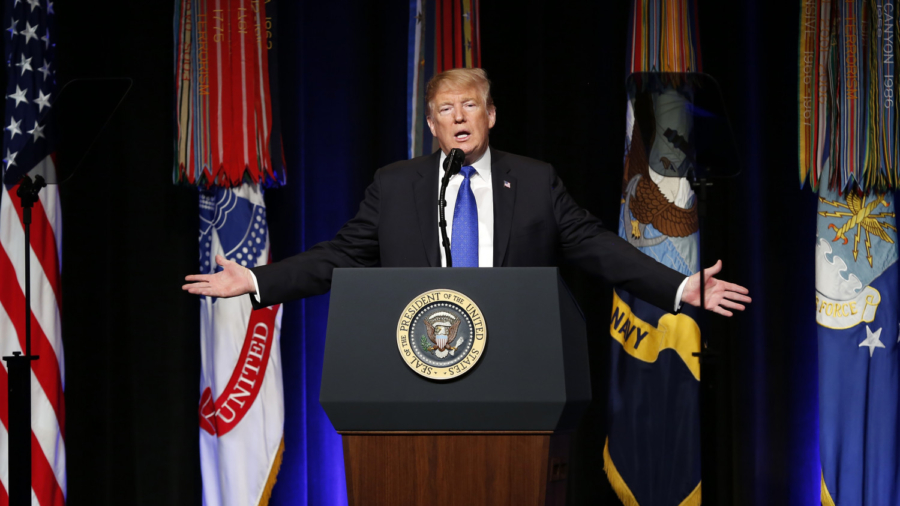President Donald Trump criticized American intelligence officials for not giving enough weight to the threat posed by Iran.
“The Intelligence people seem to be extremely passive and naive when it comes to the dangers of Iran,” Trump said in a Jan. 30 tweet. “They are wrong! When I became President Iran was making trouble all over the Middle East, and beyond.”
The comment came after the heads of major intelligence agencies testified on global national security threats before the Senate Intelligence Committee on Jan. 29.
Director of National Intelligence Dan Coats mentioned Iran in his opening statement as part of “the big four—China, Russia, North Korea, and Iran—all of which pose unique threats to the United States and our partners.”
He listed a number of Iran’s belligerent activities, including support for terrorism and various militants in the Middle East as well as Iran’s cyber warfare, missile, and nuclear programs.

But in voicing the intelligence community’s “concerns for a long term trajectory of Iranian influence in the region and the risk of conflict escalations,” he concluded by characterizing the threat posed by Iran as not particularly immediate.
Trump’s Perspective
Trump considers Iran a more urgent threat and has reimposed sanctions on the regime after withdrawing in May from the Iran nuclear deal, officially called the Joint Comprehensive Plan of Action (JCPOA), signed in 2015 by the Obama administration and Iran, China, France, Russia, United Kingdom, and Germany. The deal aimed to delay Iran’s capacity to build a nuclear weapon until 2026 in exchange for sanctions relief.
Trump’s sanctions, especially those hitting banks and oil exports, have torpedoed Iran’s economy this year, though Trump allowed Iranian oil importers to wean themselves off the supply gradually.
“Since ending the terrible Iran Nuclear Deal, they are MUCH different, but a source of potential danger and conflict,” Trump said. “They are testing Rockets (last week) and more, and are coming very close to the edge.”
Tehran went ahead with an attempt to launch a satellite into orbit on Jan. 15, despite warnings from the United S., which considered the launch Iran’s oblique way to advance its ballistic missile program, which uses much of the same technology. The launch failed, though the regime plans more.
“There [sic] economy is now crashing, which is the only thing holding them back,” Trump said. “Be careful of Iran. Perhaps Intelligence should go back to school!”
Intentions in Question
CIA Director Gina Haspel testified that Iran is still “technically in compliance” with the nuclear deal, but “the Iranians are considering taking steps that would lessen their adherence to the JCPOA as they seek to pressure the Europeans to come through with the investment and trade benefits that Iran hoped to gain from the deal.”

Yet, increasingly, it appears the Islamic regime negotiated the deal in bad faith, to begin with.
In April, Israeli Prime Minister Benjamin Netanyahu presented what he said were Iranian documents obtained by Israeli intelligence that prove Iran had been developing nuclear weapons before the 2015 deal—defying the regime’s claims the nuclear program didn’t aim for arms.
“The documents … show beyond any doubt that the Iranian regime was not telling the truth,” U.S. Secretary of State Mike Pompeo said in response to the revelation.
However, it seems the regime lied even more.

Under the JCPOA, Iran agreed to disable its heavy water reactor near Arak, a critical component in potential production of weapons-grade plutonium. The deal was that Iranians would extract the reactor core and fill it with concrete. The reactor tubing was blocked by cement in the presence of International Atomic Energy Agency inspectors, reported Iranian human rights advocate Hassan Mahmoudi.
But Ali Akbar Salehi, the head of Iran’s Atomic Agency, said on a Jan. 22 that the regime secretly procured another set of tubing which only the regime’s Supreme Leader Ali Khamenei knew about.
“As for the tubes we had, the tubes through which the fuel passes, we had bought similar tubes before, but I couldn’t declare them at the time. Only one person in Iran knew this,” Salehi told the IRIB state television in an interview.
“Only the highest authority of the regime was aware of this and no one else… His Holiness had said that you should be careful with these people, they are not trustworthy and do not keep their promises. Well, we had to work smart, and not burn the bridges behind us. We also had to build a bridge that would allow us to move faster if we had to resume our nuclear activities.”
Salehi acknowledged the spare tubing was concealed from the inspectors.
“It was a tube two or three centimeters in diameter and three or four meters long… We had purchased the same quantity of similar tubes. We were told to butcher them with cement, so we poured cement into these tubes… but we didn’t say we had other tubes,” he explained. “We will use them now.”
Pathway to Nuke
Restarting the Arak reactor would aid Iran in potentially producing weapons-grade plutonium.
While the JCPOA only allows Iran to keep a small batch of enriched uranium, it does permit the country to keep 130 tons of heavy water—plenty to launch a heavy water reactor for turning non-enriched uranium into plutonium.
And of non-enriched uranium, Iran seems to have plenty. As part of the deal, Iran traded some 9 tons of its enriched uranium for 154 tons of non-enriched uranium from Russia.
Just before Obama left office, Iran was to receive another 130 tons of non-enriched uranium from Russia in exchange for 44 tons of heavy water that, if kept, would have made Iran in breach of the JCPOA. The move was “approved by the outgoing U.S. administration and other governments seeking to keep Tehran committed to [the JCPOA],” The Associated Press learned, referring to two diplomats requesting anonymity.
From The Epoch Times


